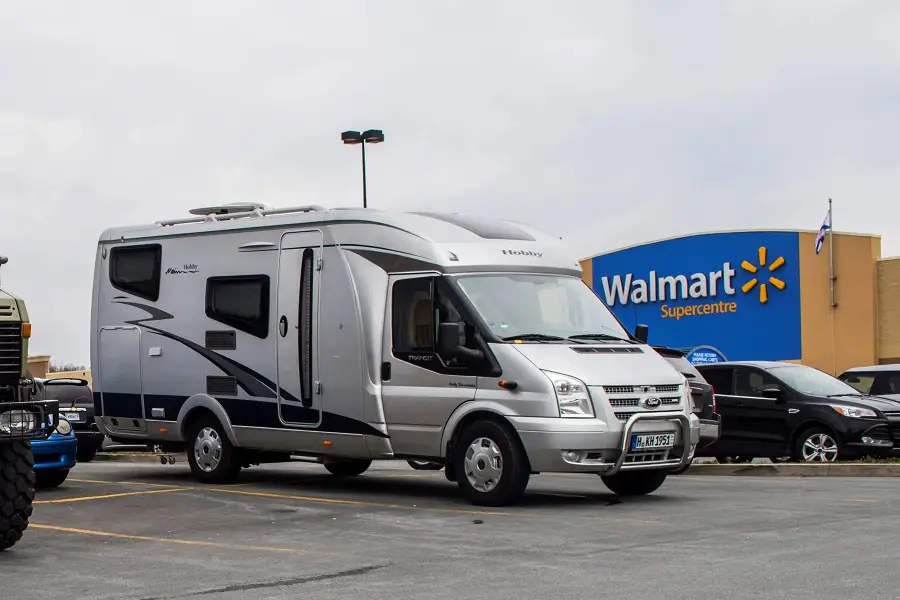Your tent is pretty important, which is why it’s the last thing you should skimp on.
We’ve taken cost into account, and devised a list of the very best camping tents on the market.
After a dozen hours of research and throwing personal experiences into the mix, based on a variety of factors listed below, these are the best camping tents you can possibly get.
Here’s Our Top Pick
Coleman Sundome 4-Person Tent
- Dome tent with spacious interior allows you to move comfortably
- Easy setup in only 10 minutes
- WeatherTec system with patented welded floors and inverted seams to...
Why is it better?
- Numerous interior storage pockets
- Affordable price
- Easy to set up
6 Best Camping Tents
With that in mind, let’s now take a closer look at our top picks.






Let’s dive into the specifics and review each tent individually. You can use the list below to jump and review specific models, or you can read along and go through all the information.
Best Overall: Coleman Sundome 4-Person Tent
- Dome tent with spacious interior allows you to move comfortably
- Easy setup in only 10 minutes
- WeatherTec system with patented welded floors and inverted seams to...
For a tent that packs a whole lot of punch at a seriously low price point, look no further than this.
The Coleman Sundome, available in 2,4, and 6-person models, is all about value for money.
It may lack the bells and whistles—aluminum poles, multiple ventilation points, ultralight weight, “bombproof” waterproofing—of the best tents from the alpine world, but for those working with a tight budget and who want a solid, reliable, spacious tent that is ideal for campsite camping and shorter backcountry outings.
You’ll be seriously hard pressed to find anything quite so functional and friendly on your bank balance.
With 63 ft² of floor space, the Sundome is a roomy option for up to three adults or a family of four.
It also boasts a decently sized porch area and enough headroom to ensure that “cabin fever” is unlikely to strike even on those days when weather conditions keep you holed up inside for hours on end.
What most impresses us about this tent is how easy it is to use.
First up, a handy, expandable carry bag makes carrying it to and from your pitching up point entirely painless.
Secondly, when you get down to the pitching, the intuitive, fuss-free, 2-pole design means setup shouldn’t take any more than 10 minutes.
PROS
- Easy to set up
- Solid weather resistance
- Nicely sized awning and porch area
CONS
- Quite heavy (10.5 lbs): not suitable for hiking or thru-trekking
- Not the best ventilation
- Stakes are quite flimsy and likely to need replacing
PRODUCT INFORMATION
- Floor area: 9’x 7’
- Height: 4’ 11’ (center)
- Capacity: 4 persons
- Material: Polyguard™ fabric (70D)
- Seasons: 2/3
- Number of poles: 2
Runner Up: CORE 9-Person Extended Dome Tent
- Sleeps 9 people; Fits three queen air mattresses; Center Height: 72...
- CORE H20 Block Technology and adjustable ground vent.Pole Type:...
- Features gear loft with lantern hook and pockets to keep items...
Few tents ever merit the description “palatial”, let alone those that also fall into the budget category of family camping tents.
The CORE Extended Dome Tent, however, does just that.
With 144 ft² of floor space (enough to fit 3 queen mattresses!) and a peak height of 72 inches, this tent is a true home away from home and for those who wish to experience all the goodness of the great outdoors whilst retaining a little more in the way of creature comfort and livability, this tent could well provide the ideal solution.
The CORE also measures up none to shabbily performance-wise, with multiple vents keeping condensation to a minimum, a removable rainfly and large mesh panels allowing for panoramic views, huge entry points, an interior gear loft and storage pockets, and a handy E-port to run an extension cord inside the tent without exposing the interior to drafts or precipitation.
While the 600mm hydrostatic head rating and lack of a vestibule area mean this tent isn’t geared towards wet-weather camping trips, for summertime adventures with all the family, a few friends, and even the family pet, it’s a solid option that’s well worth considering.
With a hydrostatic head rating of only 600mm, this tent is not built to withstand sustained and/or heavy precipitation.
As such, we’d recommend it for fair-weather campers only.
PROS
- Very spacious
- Plenty of interior storage options
- Large mesh panels are ideal for stargazing on rain-free nights
- Easy to set up for such a large tent
- Removable rainfly
CONS
- Not the most weather-resistant tent out there
- No awning over door
- No vestibule or porch area for exterior storage
- Fiberglass poles prone to breaking
PRODUCT INFORMATION
- Floor area: 16 x 9’
- Height: 72 inches (center)
- Weight: 18.2 lbs
- Capacity: 9
- Material: Durable 68D polyester
- Seasons: 2
- Number of poles: 4
Best Family Tent: Coleman Montana 8-Person Tent
- Durable, Polyguard tent fabric is made to last season after season...
- Spacious interior has room for 3 queen airbeds and has a 6 ft. 2 in....
- Snag-free, continuous pole sleeves for easy setup in about 15 minutes
For family camping adventures, you want a tent that’s big, robust, easy to set up, and that offers plenty in the way of user-friendly convenience.
If you can happen to get your hands on a tent that offers all of the above and comes in at a reasonable price, then you’re onto a winner, and that’s why the Coleman Montana 8-Person Family tent is our pick for the best family tent on the market in 2021.
This tent has a lot of things going for it, but the most lovable by far is its user-friendliness and the oodles of space it features both inside and out.
Even absolute novices to camping will be instantly endeared by this tent’s ease of setup—despite using five poles, all of these are color-coded and slip effortlessly onto the tent inner in snag-free sleeves.
All in all, getting this tent from packed to pitched shouldn’t take any more than ten minutes.
Compared to the CORE 9-person Extended Dome Tent (above), the Coleman Montana is a little narrower (7’ as opposed to 9’), but offers 2” more headroom and that all-important vestibule space the CORE lacks.
Additional features that might just win you over are the hinged door, tough, 1000D nylon floor, abundance of interior storage pockets, and a large awning over the entrance which creates a dry, sheltered vestibule area for cooking, storing gear, or changing clothes.
Like the CORE, this isn’t the best option for wet-weather camping, but for summer and shoulder-season trips with all the family it’s truly hard to beat.
PROS
- Very robust and durable materials
- Very spacious
- Excellent peak height (74”)
- Easy to set up
- Reasonably priced
CONS
- Quite poor weather resistance
- Fiberglass poles don’t inspire confidence
PRODUCT INFORMATION
- Floor area: 16’x7’ (112 ft²)
- Height: 74”
- Weight: 22.3 lbs
- Capacity: 8
- Material: 75-denier polyester taffeta fly, 68-denier polyester mesh inner tent, 1000-denier polyethylene floor
- Seasons: 2/3
- Number of poles: 5
Best Car Camping Tent: Explorer 2 SUV And Minivan Tent
- EASY SETUP - Bungy cord with plastic coated hooks attach to the...
- Outer door panels fold up and tie back for maximum ventilation, or zip...
- No-seeum insect screen.
For lovers of simplicity, car-camping tents don’t come much better than the Explorer 2 SUV and Minivan Tent.
A bit of a wild-card entry in our list, this car-camping tent attaches directly to your vehicle’s underframe to create an extended, cozy sleeping area in the trunk.
Most impressively, it can be set up in a matter minutes, leaving you to make the most of your time in your camping location and forego the many trials and tribulations suffered by users of standard camping tents.
With this tent convenience and practicality are to the fore and most users will greatly appreciate the potential to rock up at the campsite and have their sleeping space quickly taken care of
All while, we might add, the rest of their camping companions are still faffing around with the usual suspects—stubborn pole sleeves, stuck zippers, misaligned flysheets etc.—on their standard camping tents!
One factor that sets the Explorer 2 apart from the majority of its car-camping competitors is that, on most vehicles, it can be left in place when you set off for your day’s hiking or exploring, with just a slight adjustment to the cross pole allowing you to close the trunk and lock up without disturbing the tent setup.
And when you get back from your day’s adventuring, your backcountry bolthole will be waiting for you with all your camping gear safely stowed inside…bonus!
Before deciding whether you’d prefer a car-camping tent that attaches to your vehicle or standard car-camping or backpacking tent, it’s well worth asking yourself the following:
- Do you prioritize convenience and practicality over spaciousness and the true wilderness experience?
- Are you going to be happy knowing you might be missing out on experiencing the best camping spots by having to camp out only where you can take your vehicle?
- Most importantly: Is this tent compatible with my car?
PROS
- Lightweight
- Easy to use
- Keeps you off the ground (and, hence, above the creepy crawlies!)
- Durable materials
- Reasonably priced
CONS
- You miss out on the (good and bad) of the true, down-in-the-dirt camping experience!
PRODUCT INFORMATION
- Floor area: N/A
- Height: N/A
- Weight: 4.5 lbs
- Capacity: N/A
- Material: Durable 5-oz. polyester
- Seasons: 2/3
- Number of poles: 1
Best Waterproof Tent: Flytop 2-Person Backpacking Tent
- 【4 season tents for camping】The unfolding size : (23.6+55+23.6) x...
- 【Easy set up】 FLYTOP outdoor camping tent provides spacious and...
- 【WATERPROOF AND WINDPROOF】FLYTOP two person tent consists of 2...
There was a time when buying a reliable waterproof tent meant having to splash some serious cash.
Thankfully, those days are now gone thanks to weatherproof wonders like the Flystop 2-Person Backpacking Tent.
When the rain rolls in and the rest of the visitors to your campsite are upping shop and heading home in a hurry, with this tent you can kick back and let the weather do its worst, safe in the knowledge that your tent (literally) has you covered.
In short, they don’t come much more “bombproof” than this, and certainly not at this price.
Using a combination of 210D materials will hydrostatic head ratings in excess of 3500mm, this is one of the most reliably waterproof tents we’ve ever had the pleasure of waiting out a storm in.
In addition to the tough materials, it also features sturdy storm flaps around the exterior of the tent to prevent groundwater or snow entering beneath the rainfly, stormguards on each of the zippers, and double stitching with taped seams.
The design of this tent is also freestanding, meaning it’s easy to put up even if you’re camping on your lonesome and is more resistant to strong winds.
If you plan on taking your camping adventures from the summer months into the shoulder seasons or dead of winter, there are few better tents to be doing it in than this!
Before shelling out on any of the offerings of big-name brands like Black Diamond or MSR, be sure to compare the specs with those on this tent…it might just save you a small fortune.
PROS
- Solid waterproofing
- Very sturdy
- Relatively spacious
- Reasonably priced for a 4-season tent
- Easy to set up thanks to its freestanding design
- Performs well in high winds
CONS
- Small sleeping area
PRODUCT INFORMATION
- Floor area: Approximately 28 ft²
- Height: 45”
- Weight: 5.9 lbs
- Capacity: 2
- Material: 210D breathable polyester + high density fine nylon mesh (inner); 210D PU4000 mm Oxford fabric (floor); 210T PU3500mm anti-tear checkered polyester (floor)
- Seasons: 3/4
- Number of poles: 2
Best Backpacking Tent: Alps Mountaineering Lynx Tent
- Free standing, two pole design w/7000 Series aluminum poles; Easy...
- Factory sealed fly and floor seams for best weather protection; 75D...
- Vestibule for gear storage and extra weather protection; Weatherproof...
Lightweight, high-performing, bona fide backpacking tents that cost less than $100 are few and far between.
This being so, when we discover a tent that’s as reliable, lightweight, and well made as the ALPS Mountaineering Lynx, we can’t help but get a little excited.
In short, this tent is one of the best tents for the money out there, offering solid 3-season weatherproofing, ample space for one person, easy setup, a small pack size, and a wealth of handy features such as burly #8 zippers, color-coded poles, a large vestibule, a gear loft, and interior storage pockets.
It also performs as well as any 3-season backpacking tent we know in high winds and moderate rain showers and ventilates efficiently, even in relatively humid conditions.
The bottom line?
If you’re in the market for the best backpacking tent you can get your hands on, you’ll struggle to find a better option than this at even double the price.
When perusing the options of lightweight backpacking tents, you’ll come across many comparable items that cost double, sometimes even triple the bargain-basement price of the Alps Mountaineering Lynx 1-person Tent.
Don’t be fooled into thinking the big-name logo on these pricier tents means you’re necessarily getting a better product—in most cases, this performs as well as any of them.
PROS
- Lightweight
- Great price
- Windproof
CONS
- Not suitable for winter camping
PRODUCT INFORMATION
- Floor area: 21ft² (approx.)
- Height: 36”
- Weight: 4.4 lbs (3.8 lbs trail weight)
- Capacity: 1
- Material: 75D 185T Polyester Fly; 75D 185T Poly Taffeta Floor (2000mm HH rating)
- Seasons: 2/3
- Number of poles: 2
How Do I Choose A Camping Tent?
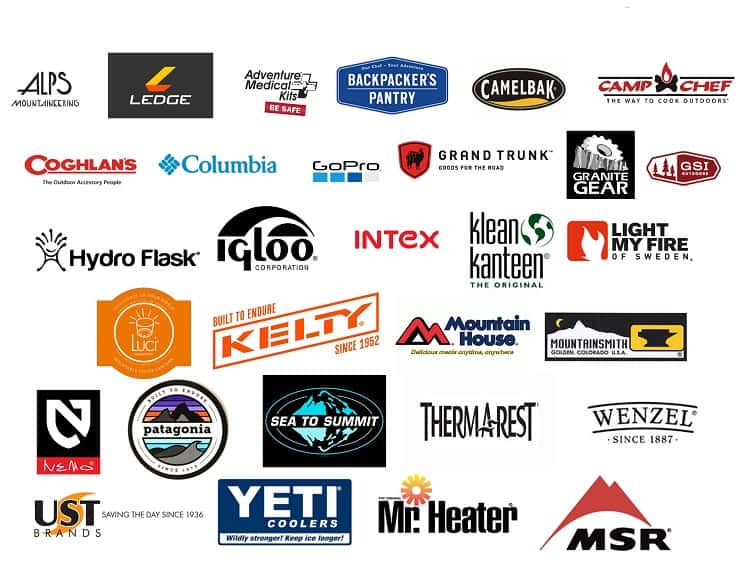
Choosing the best camping tent can be a fairly daunting experience.
Just a quick Amazon search will reveal that there are thousands of options out there, each with its own benefits and drawbacks and numerous features and failings to factor into our pre-purchase considerations.
Things are further complicated by our own unique needs as regards our group size, where we do our camping, when we do our camping, and a few further personal preferences related to expected or desired performance.
To simplify things and help you define the parameters that will narrow down your list of potential purchases, below we’ve added a series of tips and insights that will help you get your hands on the best camping tent for your needs.
Best Camping Tent Brands
As with any outdoor gear items, the number of brands out there producing camping tents runs into the dozens, if not the hundreds.
So, how are we to know which brands are best?
While we cover types of camping tent below, the following is a short, at-a-glance overview of the best tent brands per camping type:
- Alpine/Winter: MSR, Mountain Hardwear, The North Face, Black Diamond.
- Backpacking/Thru-hiking: Big Agnes, Kelty, Outdoor Research, Marmot, REI, ALPS Mountaineering.
- Car Camping and Family Camping: Coleman, Big Agnes, Kelty.
Coleman vs others
For many years, big-name camping brand Coleman has been producing high-quality, low-cost tents that have been used and enjoyed by thousands upon thousands of outdoors-goers.
But does that mean that we can cut our hunt for the perfect camping tent short and pay no notice to the competitors?
The answer is a resounding “no.”
While Coleman does offer an abundance of great tents at very reasonable prices, there are just too many other good brands out there not to take a look at what’s on offer.
If you’re in the market for a budget tent, a family tent, or a car-camping tent, Coleman’s range is best looked upon as a baseline that provides a point of reference for comparison.
Given their tents’ affordability, you can measure up the options in neighboring price categories to see what you get in return for your buck and gauge value for money based on this.
One point well worth noting is that Coleman tents are not ideal for hikers or thru-trekkers.
For the most part, Coleman’s tents are built with campsite campers in mind, lacking the portability and all-weather performance of top-end backpacking or alpine tents.
In short, if you plan on heading particularly far or high, you’d be better off perusing the ranges of brands like Black Diamond, MSR, Big Agnes, ALPS Mountaineering, or the North Face.
Types of Camping Tents
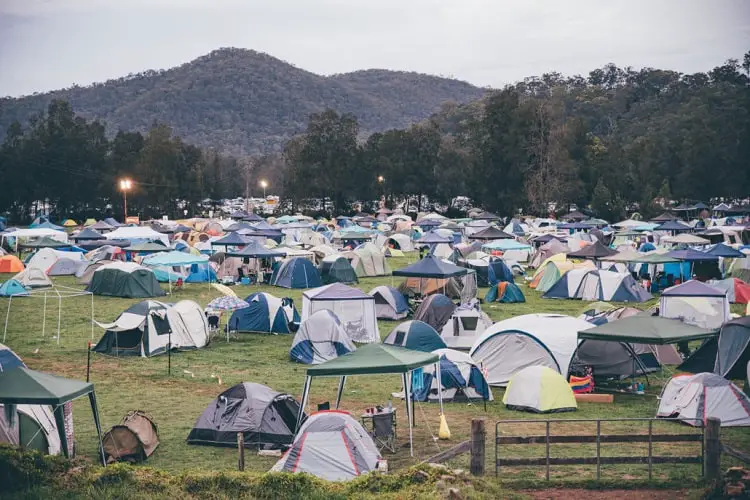
Camping tents can be categorized into four main sub-types: car-camping/roadside camping tents, family tents, alpine tents, and backpacking tents.
Roadside/car-camping tents
Because not intended for trail use or carrying long distances, these tents prioritize spaciousness and convenience over weight and portability.
Some models, such as the Explorer 2 SUV and Minivan Tent featured in our review, simplify setup and maximize convenience by attaching directly to your vehicle
Family tents
As with roadside camping tents, the best family tents prioritize space, convenience, and general livability over weight and portability
Alpine tents
Built to deal with the most extreme conditions whilst maintaining a manageable weight, these tents are generally low on space and livability but high on durability, ruggedness, and weather resistance
Backpacking tents
Built with long-distance travel in mind, these tents are usually less roomy than tents intended for the campsite and cut back on the frills and conveniences in order to achieve the lowest weight possible.
In terms of weather resistance, they usually represent a happy medium between “bombproof” alpine tents and minimally weather-resistant car-camping tents
What To Look For When Buying A Camping Tent?
Dimensions (floor area, height, ground area)
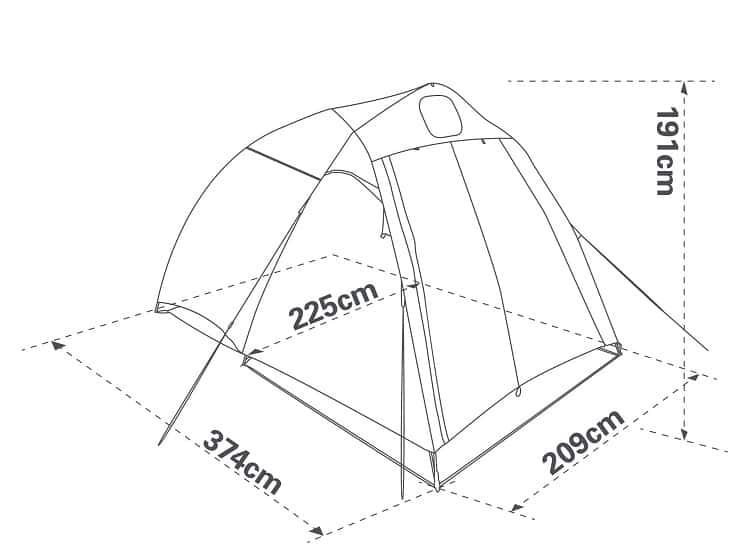
As noted above, the type of camping you plan on doing and the number of members in your group will largely dictate many of the attributes you’ll need your tent to have.
This is never more true than with the tent’s dimensions.
If you are looking for a car-camping tent or a family tent, then it’s highly likely that convenience, livability, and spaciousness all score high on your must-have tick list.
These features become even more important the longer you spend in the tent—while a “cozy” setup might be tolerable if you’re only camping for a few days at a time, on longer trips the potential for a serious dose of “cabin fever” is high and, as such, the value of every square foot of living space seriously inflated.
The best tip we can offer when buying is to ignore the capacity rating provided by the manufacturer—you wouldn’t be the first buyer to be stung when purchasing a “five-person tent” only to later discover that, in reality, it can accommodate no more than three fully-grown adults anywhere near comfortably.
To get around the ruses of the marketing folks, we recommend paying more attention to the following specs and often-overlooked details:
Square footage
The square footage of your tent is pretty much the gold standard by which you can gauge its livability.
While most manufacturers will simply provide length and width measurements (i.e 7’x9’), by multiplying these numbers you can calculate the floor area’s square footage.
Once you’ve done that, you can estimate how roomy your tent will be, using 15 square feet as a ballpark ideal allowance per adult sleeper—any less and things are going to be a little bit tight!
Peak height
The second most significant factor in contributing to livability is your tent’s peak height, which refers to the height of the tent at its tallest point.
This measurement is usually given in inches and can range from as low as 30 inches (in alpine or backpacking models) to as high as 80 inches (in campsite or family models).
When comparing tents, it’s worth noting that just a few additional inches of headroom can seriously reduce claustrophobia and boost your tent’s overall comfort and convenience levels.
Spending most of your time on hands and knees in a lower tent might be okay on a single overnighter, but on longer trips it’s sure to get old very quickly.
As such, for campsite campers and family campers, we’d recommend shooting for a tent with a peak height of at least 60 inches (5 feet) or closer to the 75”-mark if any members of your group are more than 6’ tall.
Length/Breadth
If you have any tall members in your family or camping group, they’ll greatly appreciate you taking the time to make sure your prospective backcountry residence will be capable of accommodating their oversized proportions!
When surveying the specs of your tent, check the floor plan to make sure the quoted length will suffice, being sure to factor in the additional inch or so required for the top and tail of sleeping pads.
With regard to breadth, check that the sleeping area has sufficient width to accommodate you pads plus your gear—particularly if the tent doesn’t have any covered external storage.
Vestibule area
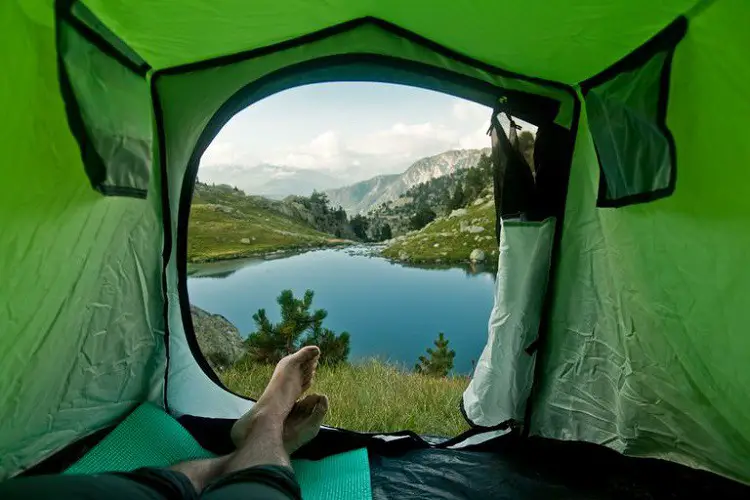
The “porch” area of any tent is a highly valuable resource.
Not only does it free up interior space by allowing you to store gear outside at night, but also provides a handy, shelter space in which you can do your cooking, change your clothes, and pack your backpack for the day’s hiking without disturbing/elbowing/otherwise assaulting your tentmates.
In a few words, the bigger the vestibule area the better.
Weather resistance
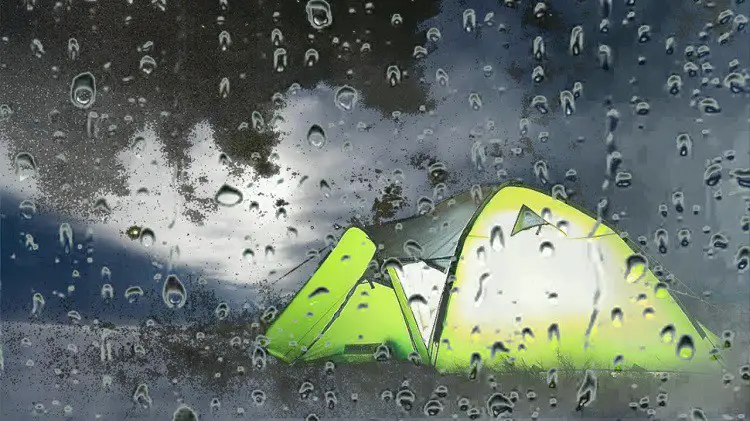
Although very few of us are likely to set off on a camping trip when the weather forecasts are warning us of the worst, weather resistance is one of the most important features to look for in any tent, whether you’re a fair-weather camper or an all-weather warrior.
Weather conditions in mountainous areas in particular are notoriously fickle and changeable and, as we all know, weather forecasting is hardly an exact science, meaning our anticipated soiree in the sun could easily end up a suffer-fest in the snow, rain, or sleet without the right gear.
But how are we to know just how waterproof a tent will be?
A tent’s waterproofing (or water resistance) is quantified with what is known as the Hydrostatic Head rating.
In short, this rating is achieved by placing an open-ended tube over the fabric used on a tent and measuring at which point the liquid poured into the tube causes the fabric to leak.
For the flysheet (or “rain fly”), the ideal hydrostatic head rating is anything above 1,000mm for summertime adventurers who are car camping, campsite camping, or camping with the family (and thus have the option of making a quick retreat to the car if all hell breaks loose from above!)
Upward of 2,000mm for those heading into more extreme mountain environments or intent on doing their camping no matter what the weather gets up to.
The added pressure placed on the floor material of your tent by its occupants and gear stored inside means that the groundsheet is far more prone to leakage.
As such, a higher hydrostatic head rating—in the region of 3,000mm—is required to make sure you aren’t visited by any uninvited liquid visitors during the night.
Ventilation
Among the contenders to the title of “Biggest Bane of the Backcountry Adventurer’s Life”, condensation ranks a close second to perhaps only mosquitoes and blisters.
Even in dry conditions, some degree of the wet stuff always seems to make its way onto our tent walls during the night, and in more basic, poorly ventilated models of tent things can often take on a vaguely aquatic feel of a morning.
Added to the condensation problem is the odor problem—given just a few days in the backcountry, the combo of sweaty gear, muck, and poor ventilation can make things fairly funky, no matter how hard we try to keep things fresh.
To minimize these problems, when buying your tent look for the following:
- Sizable ventilation panels located on the body of the tent and on the flysheet
- Flaps or awnings above the door so it can be opened without exposing the tent interior to precipitation
- A two-door design to encourage airflow
- A double-walled construction that permits air to circulate between the inner and outer sheets
Campsite Setup Tips
Now that we know what to look for in a tent, let’s turn our attention to a few simple but highly effective tips that will let you get the most out of your tent and camping experience in general.
Pick your pitching place carefully
Look for a suitably sized spot of flat land to ensure you won’t be sleeping at an angle, on the drainage route of any precipitation, and will have a level area for cooking and other campsite tasks.
If possible, avoid areas next to stagnant water as these tend to attract bugs.
Also avoid areas with roots and rocks—these will not only prove to be uncomfortable but could also damage your tent.
Tree cover may provide shelter from wind and rain, but be sure there are no large branches overhead that may fall on your tent during the night if the wind kicks up or in heavy rain.
Make use of hollows, knolls, or boulders to provide a windbreak.
Tent and cooking setup
- Pitch your tent as soon as you arrive at your proposed camping site—at this time you’ll have more energy and you can always do your cooking in the vestibule if the rain arrives later.
- Always cook downwind to ensure no fumes are blown inside the tent as this can potentially lead to carbon monoxide poisoning (and never, for the same reason, be tempted to cook inside your tent).
- If camping in bear country, invest in a bear canister to keep your supplies safe or store your food at least 150 feet from your camp, suspended 10-12 feet from the ground in a tree in a scent-proof bag or pack.
- Never take food into your tent with you when camping in bear country.
- Before going to bed, check to make sure your cooking implements are cool or are placed where they won’t be in contact with flammable materials such as the tent fly or other gear items.
Leave no trace
Carry a trash bag to carry out all refuse when leaving camp.
Establish a bathroom area at least 200ft from camp and 100 feet from any water sources.
Campfire considerations
You can read our guide to starting a campfire here.
- Make sure the wind is blowing smoke (and any hot debris) away from your tent and not towards it.
- Ensure your fire is at least 12 feet from any shrubs, trees, or deadwood in order to prevent accidental fires.
- Put your fire out with water before going to bed
- Remove any rocks used to construct your fire pit when breaking camp in order to reduce visual impact
Camping Tents – FAQ
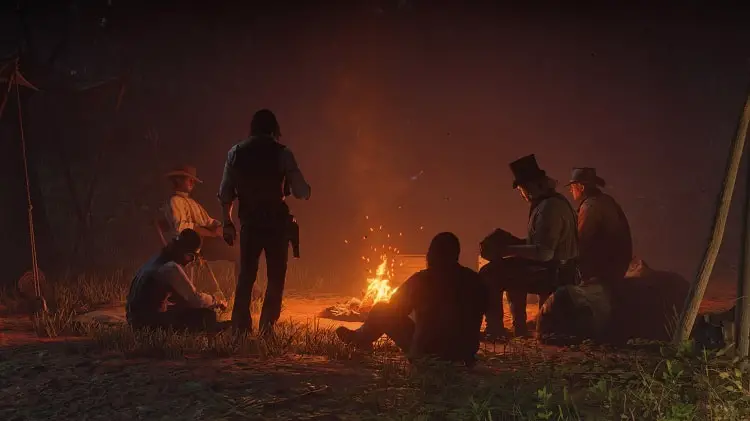
What season rating do I need?
While this will depend on what time of year you intend on doing most of your camping, we’d always recommend choosing a tent that offers slightly more weather resistance than you envision needing – i.e. a three-season tent for two-season camping, a four-season tent for shoulder-season camping.
The bottom line?
Having a little extra protection is far better than not having enough.
Should I go camping in bear country?
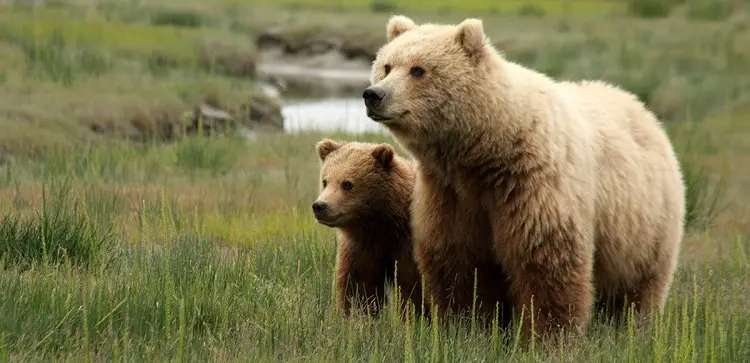
This one’s a “yes and no”.
If you think you’re going to have sleepless nights even after taking every safety precaution possible, then we’d have to say “no”.
There are plenty of attractive camping destinations where bears are not active and you’re unlikely to take much enjoyment from the trip if constantly on edge because of concerns about the big furry guys/gals.
If you’re willing to put in the time and effort required to maximize safety in bear country and think you’ll be able to enjoy yourself despite the potential presence of bears, then the answer is a definite “yes”.
Bear attacks in North America are relatively rare and, for the most part, bears want very little to do with us and will avoid contact with humans wherever possible.
That said, heading to bear country without taking the appropriate safety measures is not advisable.
When camping in bear country, be sure to carry a can of bear spray, camp in designated areas, store your food safely and learn what to do in the case of a face-to-face encounter with a bear.
I have young kids. Should I take them camping?
Absolutely!
As with adults, there are kids who adore the experience of camping and others who are not quite so enthused, but there’s really no way of knowing whether or not your kids will enjoy it unless you give it a try.
To start off, we’d recommend taking shorter trips closer to home, just in case things don’t go as well as planned.
There are, moreover, plenty of ways to make camping more fun for your kids.
For our money, the best of these is to prepare a nature scavenger hunt, which will give your kids an element of mental stimulation while they simultaneously enjoy and reap the benefits of being out in the great outdoors.
What do you do if it rains while you are camping?
In short: suck it up!
Bad weather is an integral part of the camping experience and the best advice we can give anyone stuck in their tent on a rainy day is to kick back and enjoy the downtime.
Our lives back home are full of every comfort and convenience imaginable.
Out in the wild, the lack of control we have over certain factors can be surprisingly refreshing and offer us the opportunity to do something we very rarely have the time or opportunity to do in our daily lives: nothing.
Naturally, before heading off on your trip, do everything to ensure that you’ll be ready should bad weather strike: pack your waterproof clothes, reproof your tent, boots, and jackets, allow a little leeway in your itinerary, and, of course, bring a good book*!
Can you offer any “hacks” or “tips” that will make camping easier and more fun?
We’re glad you asked!
For a list of twenty awesome tips and tricks to make your camping experience a whole lot more fun, check out our page on Twenty Camping Tips and Tricks Every Novice Should Know (N.B. The tips included are not useful for novices only!)
Where should I buy my camping and outdoor gear?
The options are numerous.
With products that you really need to try on or try out before buying—boots, clothing, stoves, and even tents—we’d recommend heading to the store to see and try the items out in person and then shopping around for the best deal.
If you’re new to camping, we’d recommend borrowing or renting kit until you know it’s going to be something you know you’ll do regularly and are ready to purchase your own gear.
How can I insulate my tent for winter camping?
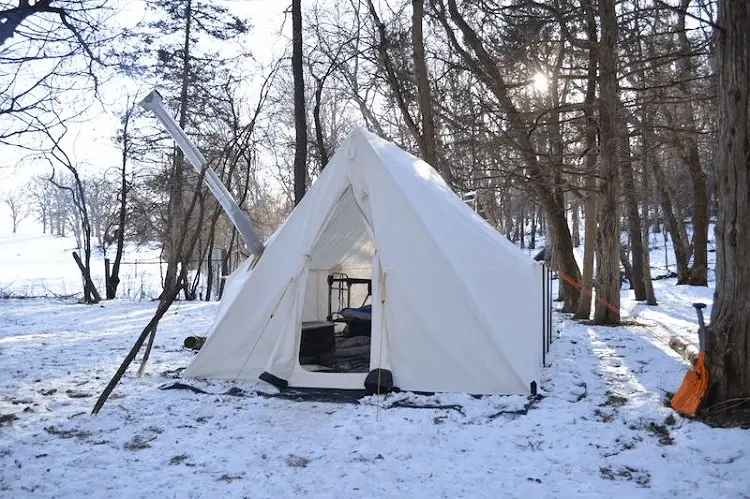
The obvious way to deal with wild and wintry weather is to buy a tent with a four-season rating.
Generally speaking, four-season tents cost a lot more than two or three-season tents, but in return you get far superior waterproofing, more substantial materials (100 denier and up), stormguards on vents and zippers, and an overall more robust construction to withstand high winds, snow, and heavy precipitation.
If, however, you’d like to sample winter camping without splurging on an expensive tent you might only use a few times per year, the following tips can help to make winter camping feasible with a regular three-season tent:
1. The smaller the better
Spaciousness is normally one of any tent’s most significant selling points.
When camping in winter, however, a roomy tent is almost a dead-cert to be a cold one.
Those with large homes or larger rooms within their homes will know only too well that smaller spaces are far more easily heated and insulated than larger ones, and in our tent the thing doing the heating (i.e or bodies!) doesn’t quite have the same output as our radiators back home!
This being so, when headed out on a winter-time camping trip, plumping for a tent that’s slightly short on space rather than slightly larger than you really need will help to keep things tolerably temperate inside.
2. Insulation begins below: get a good groundsheet
The temperature of the air inside your tent is impacted more significantly by the cold seeping through the tent floor than by cool ambient air.
As such, the most important place to double up on insulation is under your tent. This can be achieved by carrying a second groundsheet with a high denier count or even a few thick rugs to place between the groundsheet and your tent floor.
Additionally, be sure to use a thick sleeping mat and cover any exposed areas of flooring inside the tent with unused clothes in order to provide a further buffer against the cold ground beneath your tent.
3. Layer up your tent with a tarp
The two layers in double-walled tents function, to a certain extent, like the layers of our clothing, with the inner tent body acting as a baselayer that wicks “sweat” (condensation) and provides breathability, and the rainfly acting in a similar way to the outer “shell” layer by protecting us from the elements.
If conditions are really nippy, we can add a third layer to our sleeping setup in the same we can our clothing system by simply covering our tent with a large tarp and pegging it out as we would a standard rainfly.
4. Make use of natural windbreaks
Natural features such as trees, knolls, hollows, boulders, or bushes can all make for very handy and effective barriers that will keep the worst of frigid winds and drafts at bay, thereby making it easier to keep your tent insulated—and upright!— when conditions are particularly blowy.
For more on insulating your tent for winter camping, check out the following video from Deranged Survival:
how to stay warm when camping in a tent?
1. Layer up
Hitting the sack cold is a sure way to stay cold for the remainder of the night.
As soon as you arrive at your camping spot, therefore, be sure to throw on an extra layer or two to minimize heat loss while inactive around camp and, depending on the temperature, head to bed wearing thermal underwear and maybe even a fleece top—it’s far easier to cool off if things get too hot than it is to heat up once chilled.
For those using a standard (not mummy-style) sleeping bag, wear a hat or balaclava to “bed” in order to keep your prevent heat loss from your head and keep your ears warm.
2. Invest in adequate gear
In cold conditions, there really is no substitute for winter-worthy gear, most importantly a warm sleeping bag and substantial sleeping pad.
For the sleeping bag, you should look for a 4-season-rated model with a “comfort” temperature rating at least a few degrees below the coldest temperatures you expect to encounter on your camping trips.
If you’re a tosser and turner, it’s a good idea to opt for a sleeping bag with an integrated sleeping pad sleeve to ensure you don’t slip off during the night.
For a sleeping pad, loft is critical. Look for a pad that is at least 2” thick when fully inflated and large enough that no portion of your body will be in contact with the tent floor while you sleep.
3. Warm up before lying down
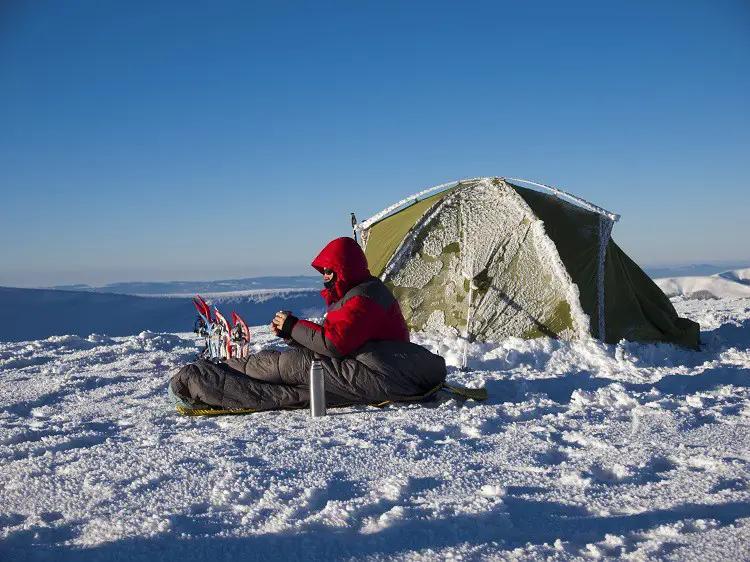
As mentioned above, if you get into your sleeping bag cold then the chances are you’ll be staying that way for quite some time.
Before you hit the hay, get your body temperature up by doing a few quick exercises outside your tent—star jumps, jogging on the spot, push ups, squats, and burpees all work well.
4. Pick a disposable heat pack (or two…)
Disposable heat packs might seem like overkill if you’ve already splurged on a solid sleeping bag and sleeping pad, but these small additions to your cold-weather camping kit can work wonders on especially chilly nights, particularly for cold sleepers.
If weight is not an issue, you can even go one step further and bring along a hot water bottle—your campmates may frown upon it at first, but you’ll be the one sleeping soundly while they’re shivering the night away next to you!
5. Give your sleeping bag a boost with a sleeping bag liner
While claims that sleeping bag liners can add a whole “season” of warmth to your sleeping setup might be exaggerated, there’s no doubting these light, cheap additions to your kit can add at least a precious degree or two of warmth on chilly nights.
As an added bonus, they also help to keep your sleeping bag clean and odor-free.
6. Pack a spare blanket

If weight isn’t an issue, there’s no harm in throwing an extra blanket in the car just in case temps are a little cooler than you anticipated.
Fleece-based, camping-specific blankets are the ideal choice, weighing as little as half a pound and squeezing down to a small, very portable bundle.
7. Toast your toes with tent slippers
Once the subject of ridicule by old-school backcountry traditionalists, tent slippers are now all the rage amongst seasoned campers and novices alike.
When pottering about your tent or popping out to take care of nature’s calls, this lightweight, very packable little addition to your camping kit will keep your feet cozy and comfy and also give them a much-needed break from your heavy hiking boots after a long day on the trails.
How to properly ventilate your tent?
A poorly ventilated tent is, more often than not, a wet and foul-smelling one.
To keep your sleeping area free of the odors from your hiking and camping gear and to minimize the build-up of condensation inside your tent, we recommend taking the following steps:
- Leave the door open if conditions (both meteorological and with regards to bugs) allow
- If it’s raining or mosquitoes are on the rampage, close the door of the tent body but leave the rainfly door at least partially open.
- Open the vents as soon as your tent is pitched.
- If it’s dry out, roll back the rainfly to expose more of the tent inner.
- To reduce condensation, store wet clothes in the vestibule area or hang them on a tree to dry out overnight.
- Avoid camping near water sources as these can increase condensation
What to bring in your tent (camping tent accessories)
A few handy accessories can make life in your tent a whole lot more livable and enjoyable.
Here are some that you might want to consider adding to your kit:
- Camping lantern
- Flashlight
- First aid kit
- A camping cooler
- Mosquito repellent
- A good camping knife
What’s the best way to store a tent when it’s not being used?
Treat your gear well and it will return the favor; treat it badly and there’s a chance your neglect and inattention will come back to haunt you somewhere down the line—usually, we might add, when you most need your gear to be at its best!
To make sure your tent remains in good nick in the long run, after every trip take the following steps:
1. When you return from your trip, remove your tent from its storage sack and dust off any dirt and debris both inside and out.
2. To prevent zippers from locking up, remove grit and dirt with an old toothbrush.
3. Hang the tent out to dry in the shade on a drying line, over a door or stair banister.
4. When your tent is completely dry, store it in a cool, dry place. (If the tent is not completely dry, it may develop mildew or the moisture may damage the polyurethane waterproof finish.)
Ideally, your tent should be hung loosely instead of packed away in a stuff sack.
For a quick overview of the things you can do to take care of your tent, take a peek at this short video from Rei.com:
Conclusion
Choosing the best camp tent for your outdoor adventures is never an easy task.
In addition to the numerous variables that come into play—season, group size, camping location, the type of camping we plan on doing—things are further complicated by our own personal preferences with regard to design, layout, and, of course, our budget.
That said, a few universally desirable attributes make certain tents stand out above their competitors, and in the above review we’ve seen a selection of the very best of them in each category and performance class.
However you plan on doing your camping and wherever you plan on heading on your future camping adventures, one of these outstanding backcountry boltholes will let you do it safely, in comfort, and in style!
References:


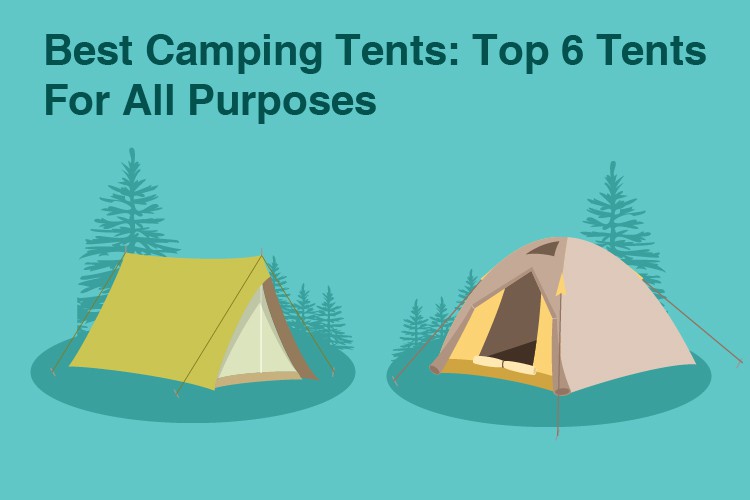

![9 Final Thoughts And Items For Your First Camper Adventure [Checklist] 39 RV Camping Checklist](https://kempoo.com/wp-content/uploads/2018/11/first-camper-adventure.jpg)
